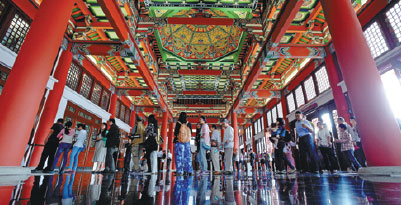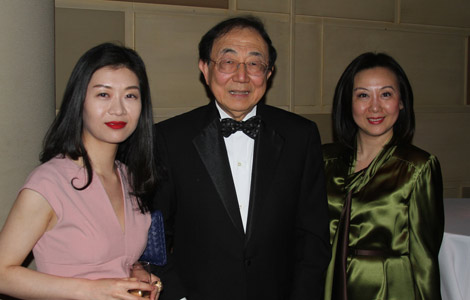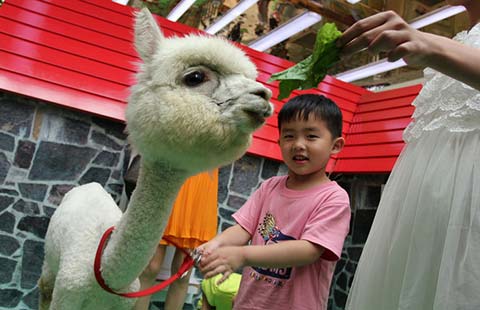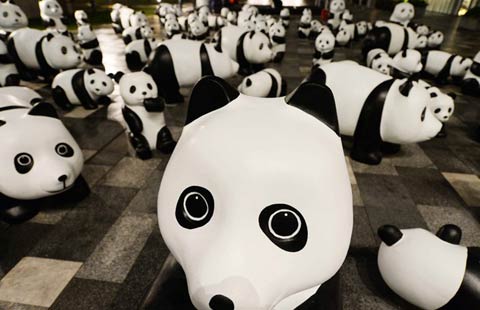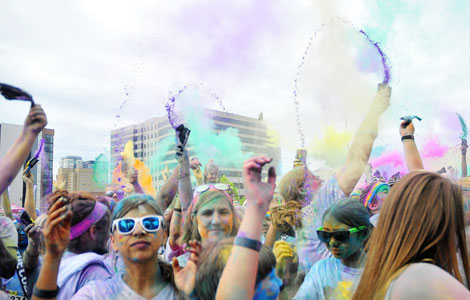Nanjing Museum captures flow of China's history
Updated: 2014-06-06 06:59
By Wang Kaihao in Nanjing (China Daily)
|
||||||||
|
Visitors to the Nanjing Museum are impressed by its architecture even before they can explore the collections inside. Anfernee / For China Daily |
The capital city of Jiangsu province, witness to the vicissitudes of many dynasties, always feels solemn.
When I step into the Nanjing Museum, which has quietly rested by the tree-lined road for over 80 years, I deeply regret that I didn't take this extraordinary time-travel experience much earlier.
Like the Forbidden City in Beijing, this museum impresses visitors with its architecture even before anyone explores the treasures indoors.
With heavy wooden beams and columns plus its upturned eaves, the dignified main hall looks ancient. But it was built in 1933, following the architectural style of the Liao Dynasty (916-1125). Facades of the new grand halls opened in 2013 perfectly coordinate with the old one.
First established as China's central museum when Nanjing was the country's capital city, the museum today covers an area of 130,000 square meters. Home of about 420,000 cultural relics, this institution is among the country's largest in terms of number of collections. About 40,000 pieces rotate in public displays.
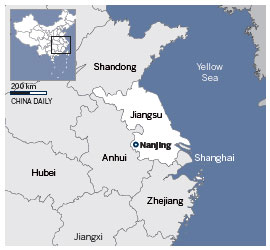
The museum is like a maze and feels much larger than it looks from outside because half of the exhibitions halls are underground. Wandering around the artifacts of Jiangsu, dating as far back as prehistoric times, the abundance forms a narrative that makes me feel like I am watching an epic movie instead of viewing individual potteries, porcelains or figurines scattered in halls. Some are only broken unrestored pieces.
"This museum is designed to show the connections between cultural relics, which are more important than individual exhibits," museum director Gong Liang says.
Some top-tier exhibits, however, deserve their own room. Eighteen pieces, ranked as highlights of the museum, take turns welcoming visitors. The most delicate among this small club: An exquisite 18th-century vase, made with enameling, painting, ivory sculptures and other techniques, features a revolving inner vessel that recreates a vivid hunting scene of Qing Emperor Qianlong (1711-99). The scenario will move when the inner vessel rolls, a marvel that may have foreshadowed the earliest dioramas.
This piece came from 13,000-odd boxes of cultural relics moved from the Forbidden City in the early 1930s to save them from the looming War of Resistance against Japanese Aggression (1937-45). Most were later sent back to Beijing and some were transferred to Taiwan as the cornerstone of the National Palace Museum in Taipei, but more than 2,000 boxes were left in Nanjing. That is why the trio across the Straits, traditionally titled the "big three museums in China" by the public, still share emotional entanglements.
After examining one excellent temporary exhibition after another - old clocks, Buddhist statues and folk art pieces - I decide to explore the underground part. On the way downstairs, I spot many corners installed with the relics' replica with Braille, a thoughtful assistant for visually impaired visitors.
The multimedia hall is my favorite as well as that of children. Children can learn how to restore antiques by playing games on a touch screen, while I can see digital projections of many items which are not on display. A blackboard in the hall provides visitors with space for graffiti. It is a perfect ironical outlet for those who scrawl their names on historical relics.
I am astonished to find a complete community of the 1930's Nanjing that was built underground like a film studio. An old-time trolley, post office and railway station portray the prosperity of China's capital at the time. What surprises me even more is that stores beside the street are not mere settings. Salespeople in long gowns or uniforms of Flying Tigers (voluntary US pilots in China fighting against Japanese invaders during World War II) smile and wave to us, holding souvenirs and showing old books and newspapers published at the time.
Sitting amid the aromas in an old-fashioned cafe, and turning a few pages of the yellowing paper, suddenly, I have a sense that time never passes.
IF YOU GO
It takes four hours on a high-speed train to get from Beijing to Nanjing, and one hour and 40 minutes from Shanghai. The Nanjing Museum is by the metro station Minggugong Stop on Line 2.
Entrance is free, but you must present an ID card to get a ticket or claim your online reservation .
Official website: www.njmuseum.com (Chinese and English, but online reservation system is only in Chinese)
Group reservation and information desk: 025-8480-7923.
9 am until noon on Monday (no entrance after 11 am)
9 am-5 pm from Tuesday to Sunday (no entrance after 4 pm).
wangkaihao@chinadaily.com.cn

 Council of Fashion Designers of America Awards
Council of Fashion Designers of America Awards
 Fan Bingbing, first Chinese actress in Barbie Hall of Fame
Fan Bingbing, first Chinese actress in Barbie Hall of Fame
 Awarding ceremony of 2014 hito Pop Music held in Taipei
Awarding ceremony of 2014 hito Pop Music held in Taipei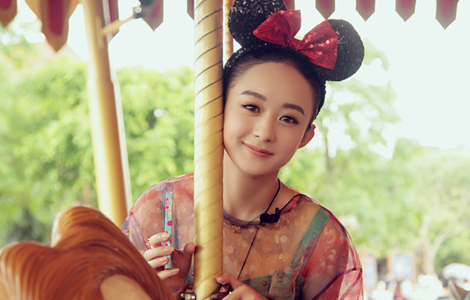
 Zhao Liying's photo shoot for Children's Day
Zhao Liying's photo shoot for Children's Day
 'Taken 2' grabs movie box office crown
'Taken 2' grabs movie box office crown
 Rihanna's 'Diamonds' tops UK pop chart
Rihanna's 'Diamonds' tops UK pop chart
 Fans get look at vintage Rolling Stones
Fans get look at vintage Rolling Stones
 Celebrities attend Power of Women event
Celebrities attend Power of Women event
Most Viewed
Editor's Picks

|

|
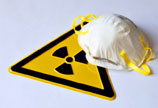
|

|
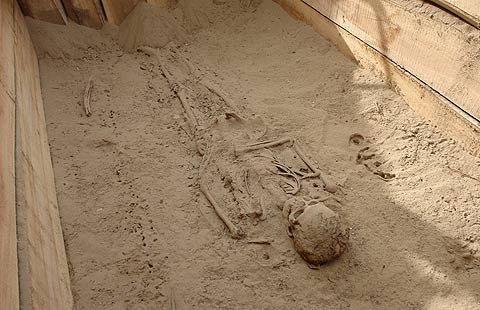
|
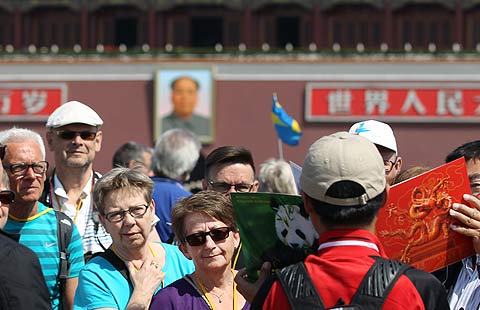
|
Today's Top News
Silk Road offers Sino-Arabian blueprint
US issues biased report on China's defense spending
Death penalties in Xinjiang reflect crackdown on terror
More Sino-US space co-op expected
NBA launches outreach in China
Clinton 'love to see' female leader
Naval drill may calm choppy ties with the US
US needs to reexamine NASA's China exclusion policy
US Weekly

|

|
